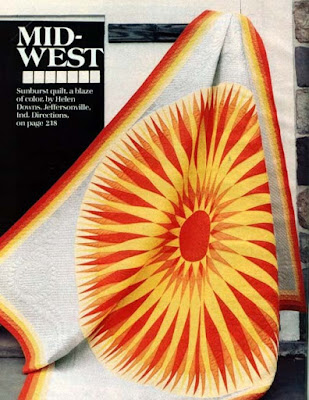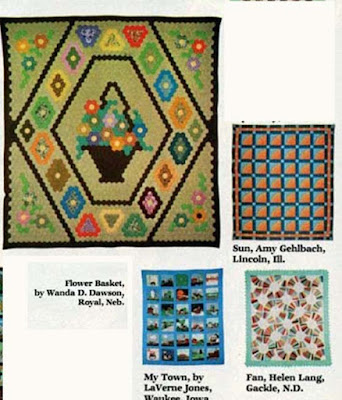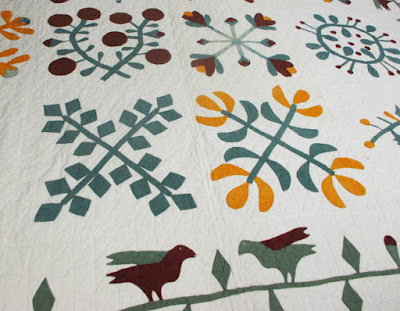A few weeks ago I wrote about Jinny Beyer as an inspiration for traditional quiltmakers over the past forty years. I looked up her ground-breaking quilt "Ray of Light" first published in Good Housekeeping magazine in March, 1978 as top prize winner in their quilt contest and realized we have an anniversary to mark.
It has been forty years since that contest, which was a big deal at the time. Nearly 10,000 quilters entered. Jinny's first prize of $2,500 was a lot of money. (My house cost $15,500 a few years earlier.) The contest undoubtedly added to the widening of interest in quiltmaking as an art form.
Chris Wolf Edmonds won the Kansas prize.
I knew some quiltmakers who entered and a couple of them won prizes, which were based on states and sections of the country.
And Erma H. Kirkpatrick the North Carolina first.
Quilt historians have used contests to get a snapshot of the community aesthetic at a certain point in time. Merikay Waldvogel and I studied the 1933 Chicago World's Fair contest fifty years later, so this is a good time to look at the 1970s trends.
Sunburst by Helen Downs of Indiana
Quilting, hard to see in the photos, must have had some influence in the judging.
Of course, hand quilting was the standard.
Machine quilting had absolutely no cachet at the time.
Caroline Riddle's "Quilted Montage" won the Tennessee prize.
Pictorial images were quite popular...
...Influenced no doubt by the 1976 fashion for pictorial Bicentennial quilts illustrating local scenery and history, such as the Rockport Bicentennial Garden Club's winner for Maine.
Of the 43 pictures I saw 26 were primarily applique. Two seemed to be of found objects (labels and drawings) and 1 was wholecloth. 11 were pieced and 2 were a combination of piecing and applique, as in this Engagement Ring or Whig's Defeat quilt by Margaret G. Brown of New Orleans.
If we throw the "pieced & appliqued" in with the pieced we have 26 applique and 13 pieced, twice as many applique quilts as pieced.
Vickie Milton's Five Star is pieced and appliqued.
White as a neutral dominates the color palette throughout the pages.
A few like the Flower Basket differed from the fashion for white.
Amy Gelbach's Sun (above) and Lisa Courtney's Confetti reflected oranges and blues
Not many explored color as well as pattern.
Very few were without white.
It's hard to see from the photos so I really can't say much about the choice of prints versus solids.
If the fabrics were printed they were generally prints that
read as solids.
Hats & Patches by Susan Jane Jones of Oregon was an exception.
Mrs. Jinny Beyer in a patchwork vest.
Here's a change.
We don't refer to artists by Miss or Mrs. anymore. Marital status is not relevant.
Joan & Walter Mondale, Vice President and wife
Where are the Tchotchkes?
Ladies in hats
The nylons may never come back but I'd love to have that coffee table.
Ruth Bader Ginsburg in 1972
She's really more my generation but look at that living room!
My current house, built in 1970, looks just like this. Have we come full circle in forty years?
Certainly in interior design.
But in quilts too?
Lots of white,
Emphasis on solid fabrics
http://www.quiltindex.org/ephemera_full_display.php?kid=1E-A3-7D5





























































